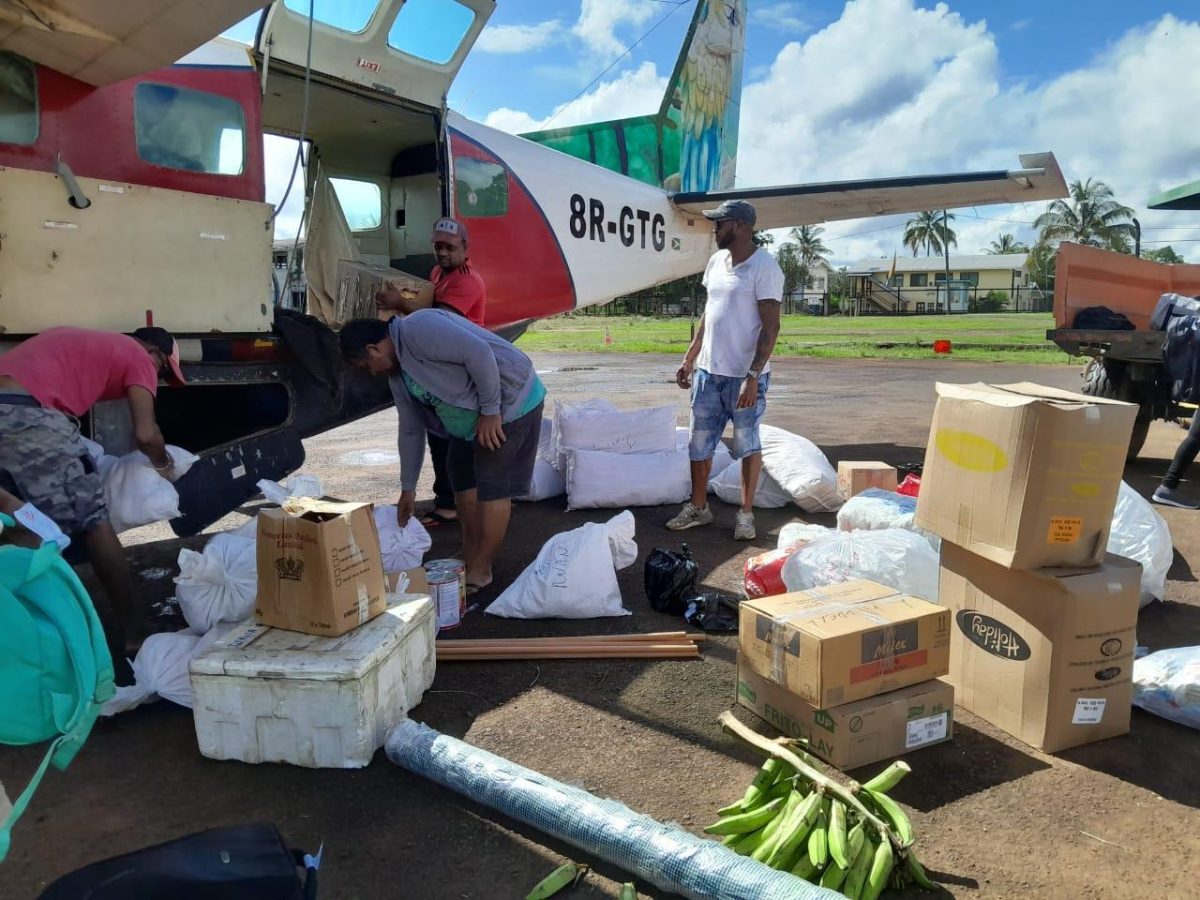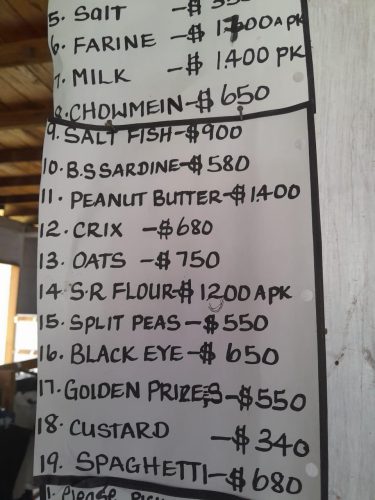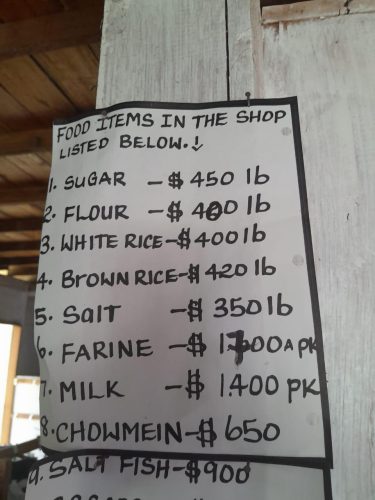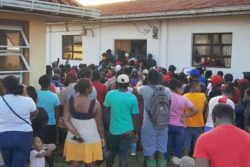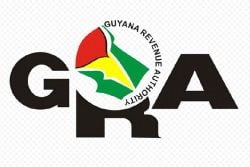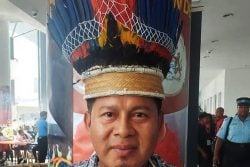Interview and photos
by Nazima Raghubir
For this week’s Cost of Living series, Nazima Raghubir spoke to people in Kako, Region Seven (Cuyuni/Mazaruni). It is an indigenous community only accessible by boat with a population of about 940 people. She also spoke to a Kamarang snackette owner. The following are their responses:
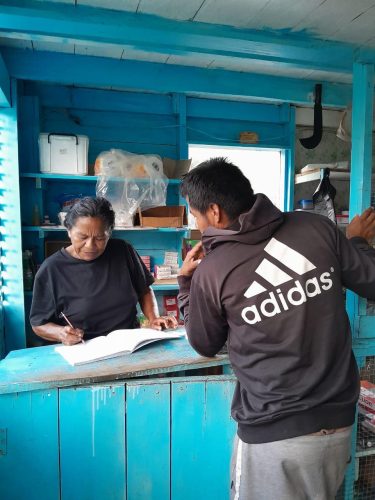 Melyn Hastings attends to acustomer and resident of Kako
Melyn Hastings attends to acustomer and resident of Kako
Melyn Hastings – Kako resident and shopkeeper
Question: “What have prices been like in the community within the last months or year?”
Answer: “Food items like chicken, it costs a lot to transport. Chicken mainly comes from Kamarang. When it gets here, sometimes we just add like $200 to the chicken to sell. Rice, we add between $50 and $100 extra on it. We not really putting plenty prices on it. We usually get goods from Kamarang, we transport it via boat, you got to burn like five gallons gas, that is gas to get from here to there. That could cost like $15,000, so the price would go a little high just to serve people. You know, we try not to add too much price on goods to exploit people. Sometimes people bring fish, local fish and telling us, your price is too high. These are things coming from the coastland to Kamarang. By flight it’s $190 per pound for any goods coming. So when you calculate all of that, it’s very high. But we have to bring things that we can’t get from town, like oil, biscuits, clothing and so.”
Question: “What are you hearing from people who come to shop here?”
Answer: “Price high, they would say. Fish is being sold at $1,500 a pound. Chicken is $900 per pound. Last year, chicken was $800 a pound.
Question: “What are people demanding more?”
Answer: “They need more food stuff more than anything else.”
Question: “How are you making ends meet here?”
Answer: “I am trying. For my home, I would have to get some stuff right here from the shop and live on it.”
Question: “You talk to other women, what are they saying about the cost of living?”
Answer: “Well when they go to town, or go to Kamarang, they see for themselves that prices are going up. I say yes, it’s happening. We cannot do anything about this high prices. There isn’t a lot of farming happening here. Small gardens, but not big farming. Sometimes people bring bora, pumpkin and so, but we don’t get a lot of vegetables. We tried to plant nuts but rats in the farm get at those nuts so we could not do anything about that. Then the Machusi ants destroyed other plants. So there are some disadvantages we facing with farming. Like when we plant cabbage, flies and pests destroy them and we don’t want to use pesticides here.”
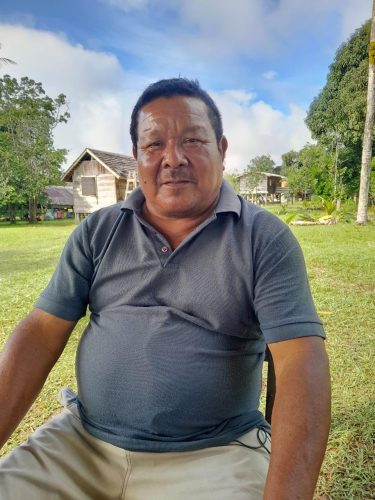 Mario Hastings – former Toshao
Mario Hastings – former Toshao
Question: “How do you get your food and ration here?”
Answer: “Most of the people here try to do a little subsistence farming and sell the extras to the neighbouring villages. We plant cassava and ground provision. But we are still highly dependent on stuff coming from Georgetown like cooking oil, salt, sugar, clothing, soap. As the years would have gone we would have seen that the cost of items would have gone up very high and we would have been told that because of the oil exploitation that is going on, that would have caused inflation. We have been told that inflation has been going up and things would increase, prices of food would continue to increase. We don’t really expect things to get better because of all that is happening. Indeed, it is very costly for you to bring stuff from Georgetown, you have to pay $190 per pound and my body weight alone, I am like 200 pounds so if you multiply that you calculate what I have to pay for my body weight plus whatever thing I have to bring. The cost of living is really high and that is why at the business centre there in Kamarang where we normally go and buy things, our needs, it would be triple and even more than it would have been purchased for. Like fuel, we are heavily dependent on fuel because we are a riverine community. Gasoline is like $3,000 a gallon. And it’s because it’s the main means of transportation. They would bring that fuel by air and that aircraft could only bring not much drums and they would have to make their profit to cover all expenses.”
Question: “What have fuel prices been like?”
Answer: “Well it has not been low, all the time fuel prices have always been high in this part of the country and also one of the reasons is that it’s mining district so people just try to take advantage of that. But now I see that some business people are coming into Kamarang. Whereas in the past there would have been one or two shops and they would take advantage of that and really sell things very expensive but I think with the increase of the business people, we have some competition and maybe, I am just assuming that, this may have seen a slight difference in the price for fuel. As I said, the cost of living remains very high.”
Question: “I see you have bread here, is it something you bring in from Kamarang?”
Answer: “Sometimes we bring it from Kamarang, from town, sometimes we get our orders from town directly. Sometimes we make bread right here and sell here. Chicken, at Kamarang you get it wholesale for $800 a pound, here is $900-$1,000 a pound. That has seen an increase over the years. Meat, I spoke about beef, it’s $1,500 to $1,600 per pound.”
Question: “You communicate with residents here, how are people making ends meet?”
Answer: “Well it is difficult for them, because they would have to depend on selling whatever extra they have from the farm. A lot of business people, they don’t like to buy these things. At Kamarang, tomatoes is $1,000 per pound, imagine that. For me, if we have to plant here you might grow with the intention that you could get it off for like $800 or at least $900 because of all the hard work, the hours, being in the backdam but people wouldn’t give you that price. I used to plant tomatoes here and years ago that used to be like $300 per pound. Rice is $450 per pint. It used to be $150 in the past, then it went up to $280 and kept climbing. Milk is $1,500 per package. Chowmein is $700. That peas is local peas grown in Waramadong and it’s $500 to $600. Milo is $1,500. Golden Cream butter is $1,200, nut butter is $1,200. Corn beef is $1,000. Eggs is $120 for one, $3,600 a tray. Recently I used to get it for $2500 per tray, so it gone up.”
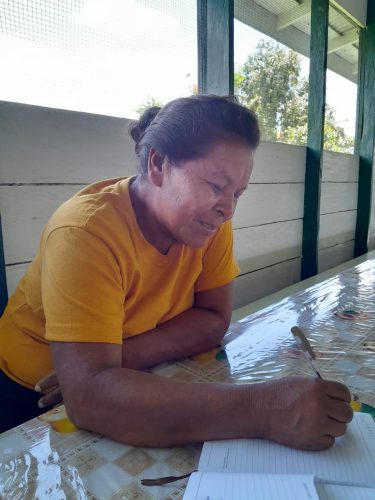 Stephanie Crammer – teacher and Kako resident
Stephanie Crammer – teacher and Kako resident
Question: “How is the cost of living affecting you?”
Answer: “There is an increase of prices in the country as a whole and more so in the Upper Mazaruni District. The prices compared to the coast are sometimes triple times, quadruple times the prices due to transportation costs. To bring the necessities from Georgetown to Upper Mazaruni is only by air so that contributes to the high cost of living in these parts.”
Question: “What are some of the trends you have seen?”
Answer: “Well for food supplies, groceries in general, that is very costly. Then clothing, especially when it comes to school supplies; children school materials, very costly. Paper and other school materials carry a price. Groceries in general are at a high cost, for example for meat, we pay for like $950 per pound for chicken and for fish we get like $1,500, that is the highest. Fuel prices, gasoline, when we have to travel, is $3,000 a gallon. Lube oil and so will cost more. When we thinking of building our homes, we have to spend a lot on transportation. Cooking oil is like $1,500 a bottle. Price for that last year was like $1,000; now all the shops selling at $1,500.”
Question: “You talk to people in the village, how are they making ends meet and how are you making ends meet?”
Answer: “Well, it is a struggle at the moment, because some families are large, mine is smaller and still sometimes I run out of items, basic items in the home and it hurts me to see other families trying to make ends meet. Sometimes they go fishing, hunting but it doesn’t be much to sustain their families and that is the reason why many of our young people. they would prefer to drop out of school and go into the mining sector, which may pay but not all the time, because gold is not there all the time. So it is really a struggle for us. So the persons that work with the government, they will try but sometimes our salaries don’t reach us in time, so we try to, you know, make ends meet with other activities just to have our families maintained.”
Question: “You’re talking about school supplies – uniforms and books – how do you get those?”
Answer: “Today I went to the shops to check on the prices because children received their grants recently and I was checking on prices. A nursery shirt would cost $1,200 for one shirt and $2,000 for a pants and that is a reality for parents. Those are all things we have to fly in.”
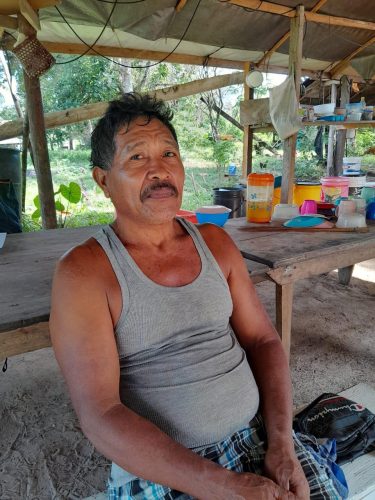 Derrick Fredricks (Kako resident)
Derrick Fredricks (Kako resident)
Question: “How have things been for the family?”
Answer: “Foodstuff and other things like rice, its $6,000 a bag, that is 10 kilos and flour is like $8,000 a bag, 10 kilos; sugar, is two parcels like 5 kilos and 10 kilos, 5 kilos is like $4,000 and 10 kilos is $6,500. And mostly, that is the cost of what we are facing now, before it used to be lil reasonable, because it had some trade stores for everyone to do business and now there is no competition for some types of businesses. We want more support from the government for these store, that would really affect how the prices are set. Mostly we have some farms to help, if we have extras, we would sell to schools. Sometimes we can’t sell to the schools cheaper, we have to plant, go into the farms and so. We have to consider also how costly it is to travel from here to Kamarang for food items. It is costly, most gasoline is $3,000 per gallon, when you calculate to go and come back, is six gallon to go and comes to $20,000 passage to go and come, just to collect some food items. So whatever comes from Kamarang to sell up here is more expensive. All those main things, like chicken, fish, all those main things, is all very costly. Fish is now $1,500 per pound; big fish from the coast. We really don’t have big fish here. Our fish is patwa, yarow, but we get them occasionally. Maybe in dry season but not all the time. We still maintain ourselves with what we have. I don’t know for how long. The money side now is really difficult. We go to mines, we get lil contracts but none of these are sufficient to maintain our families.”
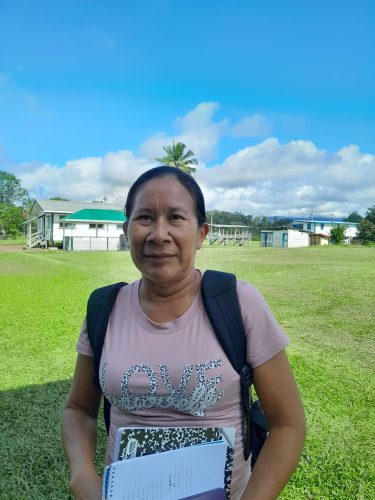 Nadira Hastings – Kako resident
Nadira Hastings – Kako resident
Question: “What is it like here in Kako to be able to afford food items?”
Answer: “Right now food items are very expensive. We try to live the life even though the cost of living is very high. Groceries carry a high price, groceries such as rice, sugar, but you know in a quick time these prices could just raise up. Fuel really, so even though they say things would be at a normal price, fuel would be at a high cost and that affects everything else. To transport things from Kamarang costs a lot.”
Question: “What is a staple meal for a family here and what is the cost you would put to that?”
Answer: “Cost of a meal? $2,000 to $2,500 in here. Most of us really try to farm to maintain the family. We sell some, we try to buy the things that we really need to make ends meet.”
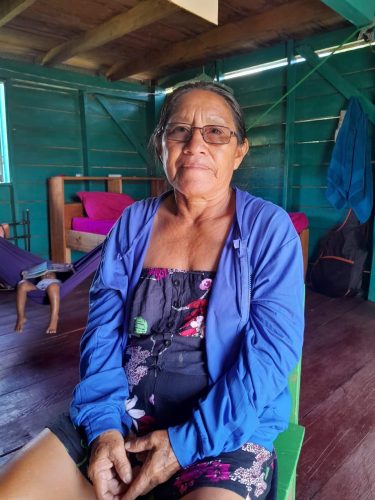 Kathleen Andrews – retired teacher/shop owner
Kathleen Andrews – retired teacher/shop owner
Question: “How are things with prices for food in Kako?”
Answer: “Things are very high as you can see. We get our goods from aircraft and then we have to use the boat to transport it so when it comes it has an extra price.”
Question: “What are some of the things you need to have for your family on a daily basis?”
Answer: “We need like tea stuff, porridge stuff, rice and sugar, those are the things we need. Those complement some of the foods we already have here. Mostly we don’t need greens, we try to plant our gardens with bora and greens. As for the groceries we buy, they are expensive, right now in Kako is $700 for oats, we purchasing it at $550 and selling it at $700. I trying to share with you my personal shopping. If I buy chicken at $700 a pound, I sell for $900, just $200 more because I don’t want to put any burden on my neighbours or friends and family. Same thing with Milo, if I buy milo at $150, I just put on $50 on that little package.”
Question: “What are people telling you about trying to make ends meet?”
Answer: “Well they are finding it very difficult. Most of our community members are living in unfortunate circumstances. To accumulate certain things for their children especially like the school supplies and so is hard. So people come to shop for school uniforms and so, it’s like $1,500 for school shirts and $2,500 for a pants and sometimes buying for one child could be expensive. It [the school grant] can’t even do for one child even though it’s $45,000. School bag alone is $5,000. A good quality bag in Georgetown is $5,000 when it come here is $7,000 or $8,000. That lil toy, an educational toy I bought for my granddaughter, $5000. And it’s worst yet with nursery children, you have to get these educational things, they all carry a price, very expensive. But we try to cope with these things.”
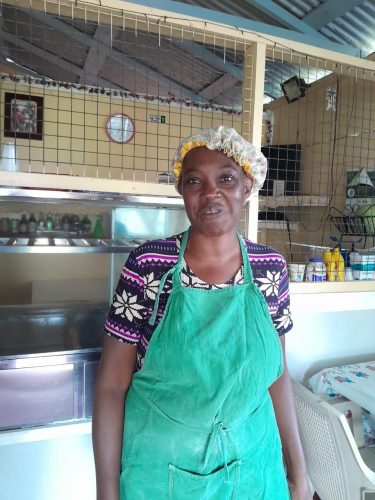 Dione James – Businesswoman/snackette owner in Kamarang
Dione James – Businesswoman/snackette owner in Kamarang
Question: “What are you noticing about prices for food and goods?”
Answer: “The prices keep going up. Sometimes it would come down but most of the times it keep climbing due to plane transportation, that is adding to the cost of living. Things is not the same, in and out, every business people got their own different prices. Right now, I pay like $15,000 to $16,000 for a pail of cooking oil; I buy by the pail. Flour you pay $6,000 a bag, that is presently now. Rice you pay $6,000 for a small bag, a big bag is $23,000 and $24,000. Flour, the big bag is the same thing, $23,000 and $25,000 at different places. Sugar is $30,000 for a big bag and the small you pay $6,000 or $5,800 depending on the place you buy from. All purpose seasoning and so you could pay 3 for $1,000, curry the same thing. But before you used to pay like $12,000 and $13,000 for a pail of cooking oil, flour and sugar was $15,000 per bag but not now.”
Question: “How do these prices affect you and the service you provide here to people?”
Answer: “Very hard sometimes, very difficult sometimes. I try to make do with it but people try to understand that these are the prices we pay and we have to charge for food. My family is here and it’s very hard because I have a little money for the airline, they normally bring and you pay but due to business, I have a little money for them. I trying to pay piece by piece to finish off and the children school coming up. It will be hard. Because I sending my daughter to secondary. I trying to see if I could get her into Bartica, because if I send her to Waramadong to get there by vehicle is very expensive, $6,000 or $8,000 to go into the village and to come out back. With boat, a gallon of gas is $3,000 and you got to get like 3 or 4 gallons to go in and come out. So if you calculate that you will see the cost to send my daughter to school. It is still costly to go to the school and come back.”
OTHER IMAGES
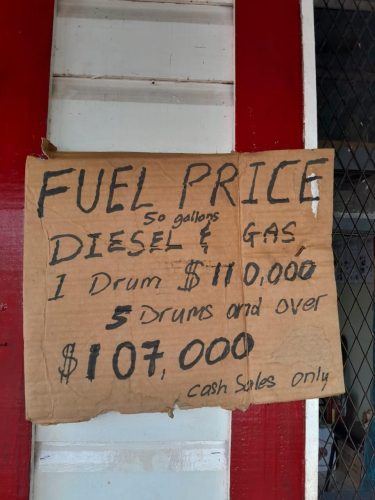 Fuel price sign in Kamarang. The price for fuel usually dictates the cost for transportation of goods and prices to the riverine communities.
Fuel price sign in Kamarang. The price for fuel usually dictates the cost for transportation of goods and prices to the riverine communities.
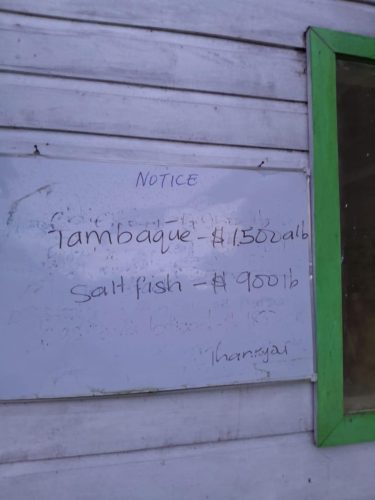 A Kako shop displays prices for special and in demand food items
A Kako shop displays prices for special and in demand food items
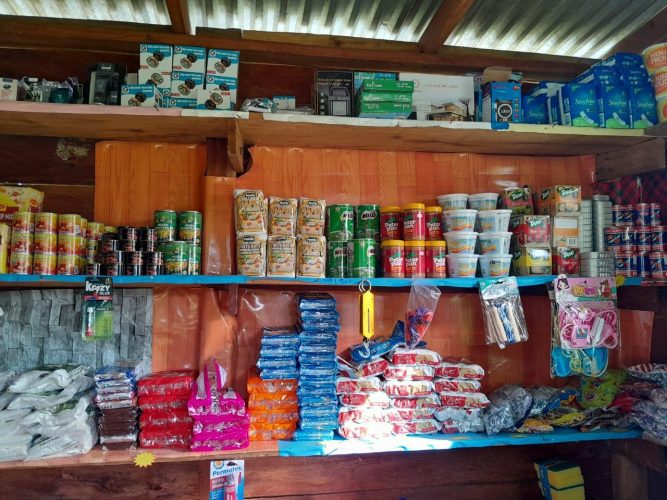 Canned and packaged goods carry a heavy price in Kako
Canned and packaged goods carry a heavy price in Kako
Price list displayed in a Kako shop
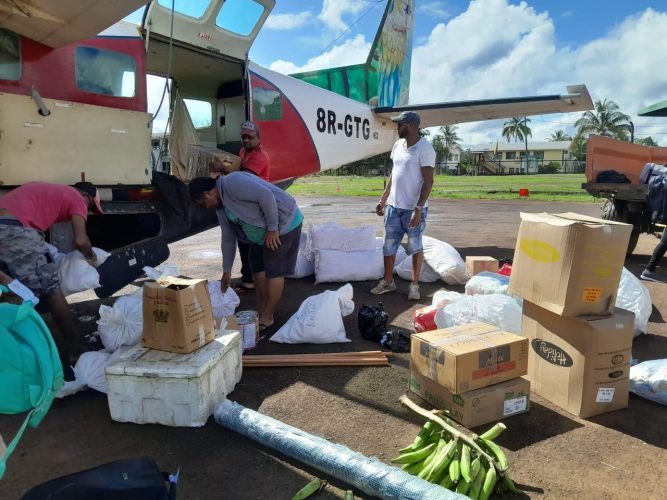 Food and other items transported from Georgetown to Kamarang being offloaded
Food and other items transported from Georgetown to Kamarang being offloaded
